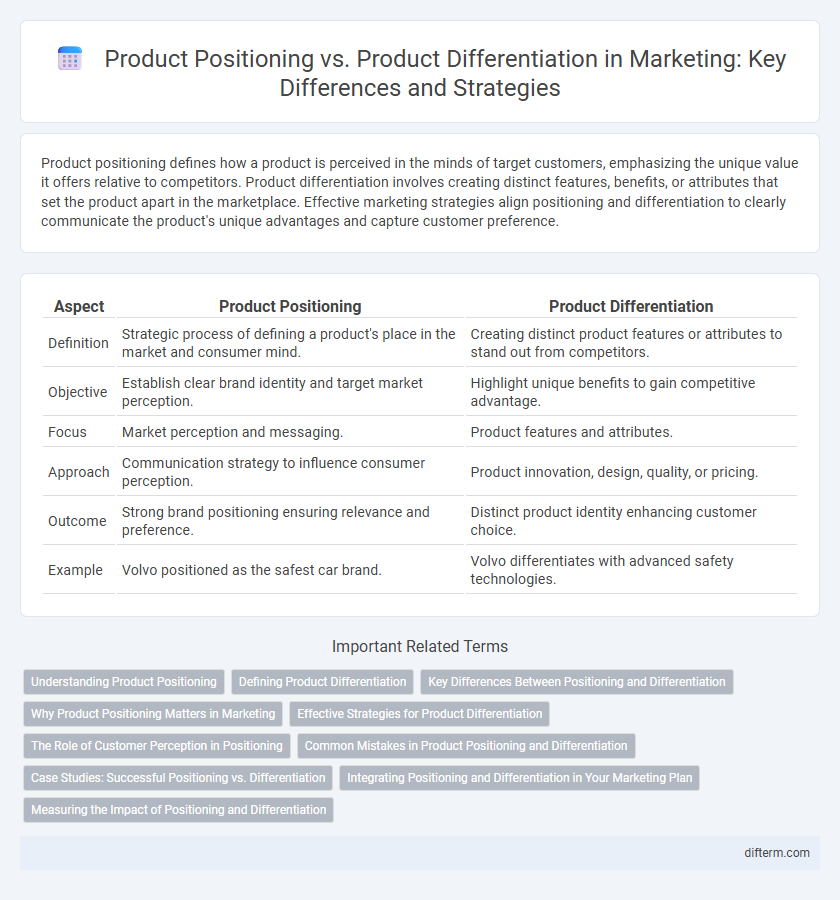Product positioning defines how a product is perceived in the minds of target customers, emphasizing the unique value it offers relative to competitors. Product differentiation involves creating distinct features, benefits, or attributes that set the product apart in the marketplace. Effective marketing strategies align positioning and differentiation to clearly communicate the product's unique advantages and capture customer preference.
Table of Comparison
| Aspect | Product Positioning | Product Differentiation |
|---|---|---|
| Definition | Strategic process of defining a product's place in the market and consumer mind. | Creating distinct product features or attributes to stand out from competitors. |
| Objective | Establish clear brand identity and target market perception. | Highlight unique benefits to gain competitive advantage. |
| Focus | Market perception and messaging. | Product features and attributes. |
| Approach | Communication strategy to influence consumer perception. | Product innovation, design, quality, or pricing. |
| Outcome | Strong brand positioning ensuring relevance and preference. | Distinct product identity enhancing customer choice. |
| Example | Volvo positioned as the safest car brand. | Volvo differentiates with advanced safety technologies. |
Understanding Product Positioning
Product positioning defines how a product is perceived in the minds of target consumers relative to competitors, emphasizing attributes that meet specific customer needs. Clear product positioning leverages market research, competitive analysis, and customer insights to create a unique value proposition that resonates with the target audience. Effective positioning enhances brand recognition, drives customer loyalty, and establishes a foundation for strategic marketing efforts.
Defining Product Differentiation
Product differentiation refers to the process of distinguishing a product from competitors' offerings by emphasizing unique features, quality, or benefits that appeal to a specific target audience. Effective differentiation highlights aspects like design, functionality, performance, or customer service that create a competitive advantage and justify premium pricing. This strategic approach enables brands to capture consumer attention and build loyalty in crowded markets by fulfilling unmet needs or preferences.
Key Differences Between Positioning and Differentiation
Product positioning defines how a product is perceived in the minds of target customers, emphasizing specific attributes or benefits relative to competitors. Product differentiation highlights the unique features, quality, or performance aspects that set the product apart in the market. Positioning shapes the brand image and customer perception, while differentiation focuses on tangible product distinctions that create competitive advantage.
Why Product Positioning Matters in Marketing
Product positioning establishes a brand's unique value in the consumer's mind, directly influencing purchase decisions and market share. Effective positioning clarifies the product's benefits compared to competitors, enhancing customer perception and driving loyalty. Strong product positioning aligns marketing strategies with target audience needs, maximizing impact and return on investment.
Effective Strategies for Product Differentiation
Effective strategies for product differentiation hinge on highlighting unique features that address specific customer needs, thereby creating a distinct market identity. Leveraging quality enhancements, innovative design, or exceptional customer service can significantly elevate perceived value and foster brand loyalty. Integrating customer feedback and competitive analysis ensures differentiation efforts remain relevant and resonate with target audiences, boosting overall marketing performance.
The Role of Customer Perception in Positioning
Customer perception plays a pivotal role in product positioning by shaping how target audiences identify and emotionally connect with a brand compared to competitors. Effective positioning strategies leverage insights into customer preferences, needs, and pain points to create a distinct market image that resonates and drives loyalty. Product differentiation supports positioning by highlighting unique features, but it is the customer's interpretation and value assignment that ultimately determine market success.
Common Mistakes in Product Positioning and Differentiation
Common mistakes in product positioning include vague messaging that fails to resonate with target audiences, leading to brand confusion and lost market opportunities. Overemphasizing product features instead of unique benefits can hinder effective differentiation and reduce perceived value. Neglecting continuous market research may result in outdated positioning strategies that do not address evolving consumer needs or competitive landscapes.
Case Studies: Successful Positioning vs. Differentiation
Case studies of successful product positioning include Apple, which leverages sleek design and user-friendly interfaces to create a distinct market identity, and Tesla, which positions itself as a leader in sustainable innovation and cutting-edge technology. In contrast, product differentiation is exemplified by Coca-Cola, which differentiates through unique taste variations and extensive branding, and Nike, which focuses on innovative product features and athlete endorsements to stand out in a crowded market. These examples demonstrate how strategic positioning builds brand perception while differentiation emphasizes unique product attributes to capture diverse consumer segments.
Integrating Positioning and Differentiation in Your Marketing Plan
Integrating product positioning and product differentiation in your marketing plan enhances brand clarity and competitive advantage by clearly defining your product's unique value and target market. Effective positioning aligns your messaging with specific customer needs, while differentiation emphasizes distinct features that set your product apart from competitors. Combining both strategies ensures a cohesive approach that drives customer preference and supports long-term market success.
Measuring the Impact of Positioning and Differentiation
Measuring the impact of product positioning involves assessing brand perception, customer engagement, and market share changes through tools like surveys, focus groups, and sales data analysis. Product differentiation effectiveness is evaluated by examining unique value proposition recognition, customer loyalty, and competitive advantage metrics, often utilizing market segmentation and competitor benchmarking. Combining quantitative data from KPIs and qualitative insights ensures a comprehensive understanding of how positioning and differentiation drive business growth and customer preference.
Product Positioning vs Product Differentiation Infographic

 difterm.com
difterm.com